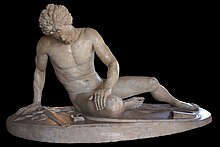Historiography of Romanisation
[3] Romanisation, as a term, was first coined in 1885 by Theodore Mommsen who held the imperial view that Roman culture was superior to provincial ones."[5] The historiography of Romanisation involves many contentions and varied opinions as time goes on and the influencing context, views and values of historians evolves.Many in antiquity, such as Caesar, Pliny the Elder, Propertius, Ovid and Martial, use the Britons dying their bodies with woad (to produce blue and green) as an indication of their otherness.[2] in his Agricola, a biography of his father-in-law's and his command in Britain, stating that the introduction of Latin, baths, "sumptuous banquets", and togas was "in their ignorance they called culture, when in fact it was just one facet of their enslavement"[10] Tacitus's opinion on the superiority of Romans can be seen in his use of language in his construction of history, such as "primitive",[10] to describe provincial peoples.His poems Tristia ("Sorrows") and Epistulae ex Ponto ("Letters from the Black Sea") written during his exile to a remote city called Tomis on the Black Sea has been interpreted by historians, such as Thomas Habinek, to display Rome as the "necessary centre of the empire", as the root of artistic and political authority and Tomis as an uncivilised, mostly barbarian and culture less city.He did not define the term but his view of the spreading for Roman power falls in-line with the later definition by his pupil, Francis Haverfield.[4] His review of epigraphic evidence aided in modifying earlier understanding of Roman social change into something more dynamic and accurate.[17] The British archaeologist and historian Martin Millett (1955 – ) argues that the Romanisation process was led by the provincial elite in a "native-led emulation"[19] which then spread down to all levels of society.She points out that the local population was significantly contributing to their own development as a Roman province, and not as a result of the power and occupation of Rome.The material evidence that Beard uses to support her argument, such as pottery, foods, clothing and other everyday items, that it was the native population that made their own choice to emulate the Romans.


RomanisationRoman civilisation and cultureacculturationintegrationassimilationTheodore MommsenimperialRoman culturestructuralistshistoriographyRoman Empirecolonialismpost-colonialpost-modernCaesarPliny the ElderPropertiusMartialCassius DioStraboGaius Cornelius TacitusoratorTacitusGermaniaAgricolaHistoriesAnnalsConstantaAugustusTristiaEpistulae ex PontoBlack SeaThomas HabinekMetamorphosesEdward GibbonParliamentImperial British EmpireThe History of the Decline and Fall of the Roman EmpireTheodor MommsenFrancis HaverfieldRoman-BritainMommsencivilizationcolonial perspectiveRoman Baths in Bath, EnglandhomogenisationR.G. CollingwoodphilosopherHaverfieldRoman BritainCelticRomano-BritishA.N. Sherwin-WhiteMartin MillettDying GaulCapitoline MuseumsrevisionistGreg WoolfcreolizationSarah ScottMary BeardclassicistDeWitte, Sharon N.Historiansby area of studyHistoryHistorical sourcesPrimary sourcesSecondary sourcesTertiary sourcesArchivesArtifactsArchaeological siteChroniclesCodicesFacsimilesFeaturesHieroglyphsHistorical documentsLogbooksManuscriptsIlluminatedOral traditionPapyriReligious textsScrollsWar diariesService recordsFields of studyBig HistoryWorld historyHuman historyLocal historyMicrohistoryArchival scienceLibrary and information scienceWriting systemsChorographyChronologydatingDiplomaticsEncyclopaedisticsEpigraphyGenealogyHeraldryNumismatics (Money)OnomasticsOral historypreservationPhaleristicsPhilologyPostage stampsProsopographySigillographyToponymyVexillologyAnthropologyPaleoanthropologyCulturalEcologyEnvironmentGeographyEconomicBusinessCapitalismPerspectives on capitalism by school of thought




